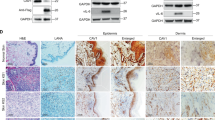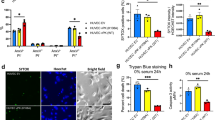Abstract
Kaposi's sarcoma (KS)-associated herpesvirus (KSHV) is involved in the pathogenesis of KS, primary effusion lymphoma, and multicentric Castleman's disease. K-bZIP, the protein encoded by the open reading frame K8 of KSHV, is a member of the basic region-leucine zipper family of transcription factors. We studied the mechanisms that underlie KSHV-induced oncogenesis by investigating whether K-bZIP perturbs signaling through transforming growth factor β (TGF-β), which inhibits proliferation of a wide range of cell types. K-bZIP repressed TGF-β-induced, Smad-mediated transcriptional activity and antagonized the growth-inhibitory effects of TGF-β. Since both K-bZIP and Smad are known to interact with CREB-binding protein (CBP), the effect of CBP on inhibition of Smad-mediated transcriptional activation by K-bZIP was examined. K-bZIP mutants, which lacked the CBP-binding site, could not repress TGF-β-induced or Smad3-mediated transcriptional activity. Overexpression of CBP restored K-bZIP-induced inhibition of Smad3-mediated transcriptional activity. Competitive interaction studies showed that K-bZIP inhibited the interaction of Smad3 with CBP. These results suggest that K-bZIP, through its binding to CBP, disrupts TGF-β signaling by interfering with the recruitment of CBP into transcription initiation complexes on TGF-β-responsive elements. We propose a possibility that K-bZIP may contribute to oncogenesis through its ability to promote cell survival by repressing TGF-β signaling.
This is a preview of subscription content, access via your institution
Access options
Subscribe to this journal
Receive 50 print issues and online access
$259.00 per year
only $5.18 per issue
Buy this article
- Purchase on Springer Link
- Instant access to full article PDF
Prices may be subject to local taxes which are calculated during checkout








Similar content being viewed by others
Abbreviations
- KSHV:
-
Kaposi's sarcoma-associated herpesvirus
- PEL:
-
primary effusion lymphoma
- CBP:
-
CREB-binding protein
- NF:
-
nuclear factor
- TGF-β:
-
transforming growth factor β
- TβRII:
-
type II TGF-β receptor
- TβRI:
-
type I TGF-β receptor
- PAI:
-
plasminogen activator inhibitor
- ARE:
-
activin response element
- EMSA:
-
electrophoretic mobility shift assay
References
Alkan S, Karcher DS, Ortiz A, Khalil S, Akhtar M and Ali MA . (1997). Br. J. Haematol., 96, 412–414.
Arvanitakis L, Geras-Raaka E, Varma A, Gershengorn MC and Cesarman E . (1997). Nature (Lond.), 385, 347–350.
Bex F, Yin M-J, Burny A and Gaynor RB . (1998). Mol. Cell. Biol., 18, 2392–2405.
Blobe GC, Schiemann WP and Lodish HF . (2000). N. Engl. J. Med., 342, 1350–1358.
Boshoff C . (1998). Nature (Lond.), 391, 24–25.
Boshoff C, Endo Y, Collins PD, Takeuchi Y, Reeves JD, Schweickart VL, Siani MA, Sasaki T, Williams TJ, Gray PW, Moore PS, Chang Y and Weiss RA . (1997). Science (Wash. DC), 278, 290–294.
Boshoff C, Schulz TF, Kennedy MM, Graham AK, Fisher C, Thomas A, McGee JO, Weiss RA and O'Leary JJ . (1995). Nat. Med., 1, 1274–1278.
Cesarman E, Chang Y, Moore PS, Said JW and Knowles DM . (1995). N. Engl. J. Med., 332, 1186–1191.
Chan HM and La Thangue NB . (2001). J. Cell Sci., 114, 2363–2373.
Chang Y, Cesarman E, Pessin MS, Lee F, Culpepper J, Knowles DM and Moore PS . (1994). Science (Wash. DC), 266, 1865–1869.
Chen F and Weinberg R . (1995). Proc. Natl. Acad. Sci. USA, 92, 1565–1569.
Chen X, Rubock MJ and Whitman M . (1996). Nature (Lond.), 383, 691–696.
Chen X, Weisberg E, Fridmacher V, Watanabe M, Naco G and Whitman M . (1997). Nature (Lond.), 389, 85–89.
Datto M, Hu P, Kowalik T, Yingling J and Wang X . (1997). Mol. Cell. Biol., 17, 2030–2037.
Dennler S, Itoh S, Vivien D, ten Dijke P, Huet S and Gauthier JM . (1998). EMBO J., 17, 3091–3100.
Feng XH, Zhang Y, Wu RY and Derynck R . (1998). Genes Dev., 12, 2153–2163.
Harrod R, Tang Y, Nicot C, Lu HS, Vassilev A, Nakatani Y and Giam C-Z . (1998). Mol. Cell. Biol., 18, 5052–5061.
Horvai AE, Xu L, Korzus E, Brard G, Kalafus D, Mullen TM, Rose DW, Rosenfeld MG and Glass CK . (1997). Proc. Natl. Acad. Sci. USA, 94, 1074–1079.
Huang YQ, Li JJ, Kaplan MH, Poiesz B, Katabira E, Zhang WC, Feiner D and Friedman-Kien AE . (1995). Lancet, 345, 759–761.
Hwang S, Gwack Y, Byun H, Lim C and Choe J . (2001). J. Virol., 75, 9509–9516.
Janknecht R, Wells NJ and Hunter T . (1998). Genes Dev., 12, 2114–2119.
Kamei Y, Xu L, Heinzel T, Torchia J, Kurokawa R, Gloss B, Lin SC, Heyman RA, Rose DW, Glass CK and Rosenfeld MG . (1996). Cell, 85, 403–414.
Katano H, Sato Y, Kurata T, Mori S and Sata T . (2000). Virology, 269, 335–344.
Labbe E, Silvestri C, Hoodless PA, Wrana JL and Attisano L . (1998). Mol. Cell, 2, 109–120.
Lee CW, Sorensen TS, Shikama N and La Thangue NB . (1998). Oncogene, 16, 2695–2710.
Lin S-F, Robinson DR, Miller G and Kung H-J . (1999). J. Virol., 73, 1909–1917.
Massague J . (1998). Annu. Rev. Biochem., 67, 753–791.
Memar OM, Rady PL and Tyring SK . (1995). J. Mol. Med., 73, 603–609.
Miyazono K, ten Dijke P, Yamashita H and Heldin CH . (1994). Semin. Cell Biol., 5, 389–398.
Moore PS and Chang Y . (1995). N. Engl. J. Med., 332, 1181–1185.
Mori N, Fujii M, Iwai K, Ikeda S, Yamasaki Y, Hata T, Yamada Y, Tanaka Y, Tomonaga M and Yamamoto N . (2000). Blood, 95, 3915–3921.
Mori N, Morishita M, Tsukazaki T, Giam CZ, Kumatori A, Tanaka Y and Yamamoto N . (2001). Blood, 97, 2137–2144.
Mori N, Morishita M, Tsukazaki T and Yamamoto N . (2003). Int. J. Cancer, 105, 661–668.
Nishihara A, Hanai J, Imamura T, Miyazono K and Kawabata M . (1999). J. Biol. Chem., 274, 28716–28723.
Nishihara A, Hanai JI, Okamoto N, Yanagisawa J, Kato S, Miyazono K and Kawabata M . (1998). Genes Cells, 3, 613–623.
Park J, Seo T, Hwang S, Lee D, Gwack Y and Choe J . (2000). J. Virol., 74, 11977–11982.
Portes-Sentis S, Manet E, Gourru G, Sergeant A and Gruffat H . (2001). J. Gen. Virol., 82, 507–512.
Pouponnot C, Jayaraman L and Massague J . (1998). J. Biol. Chem., 273, 22865–22868.
Shen X, Hu PP, Liberati NT, Datto MB, Frederick JP and Wang XF . (1998). Mol. Biol. Cell, 9, 3309–3319.
Sheppard KA, Phelps KM, Williams AJ, Thanos D, Glass CK, Rosenfeld MG, Gerritsen ME and Collins T . (1998). J. Biol. Chem., 273, 29291–29294.
Song CZ, Siok TE and Gelehrter TD . (1998). J. Biol. Chem., 273, 29287–29290.
Soulier J, Grollet L, Oksenhendler E, Cacoub P, Cazals-Hatem D, Babinet P, d'Agay M-F, Clauvel J-P, Raphael M, Degos L and Sigaux F . (1995). Blood, 86, 1276–1280.
Sporn MB and Roberts AB . (1990). Ann. NY Acad. Sci., 593, 1–6.
Staskus KA, Zhong W, Gebhard K, Herndier B, Wang H, Renne R, Beneke J, Pudney J, Anderson DJ, Ganem D and Haase AT . (1997). J. Virol., 71, 715–719.
Sun R, Lin SF, Staskus K, Gradoville L, Grogan E, Haase A and Miller G . (1999). J. Virol., 73, 2232–2242.
Topper JN, DiChiara MR, Brown JD, Williams AJ, Falb D, Collins T and Gimbrone Jr MA . (1998). Proc. Natl. Acad. Sci. USA, 95, 9506–9511.
Tsukazaki T, Chiang TA, Davison AF, Attisano L and Wrana JL . (1998). Cell, 95, 779–791.
Wadgaonkar R, Phelps KM, Haque Z, Williams AJ, Silverman ES and Collins T . (1999). J. Biol. Chem., 274, 1879–1882.
Wrana JL, Attisano L, Wieser R, Ventura F and Massague J . (1994). Nature (Lond.), 370, 341–347.
Zawel L, Dai JL, Buckhaults P, Zhou S, Kinzler KW, Vogelstein B and Kern SE . (1998). Mol. Cell, 1, 611–617.
Zhang Y, Feng X, We R and Derynck R . (1996). Nature (Lond.), 383, 168–172.
Zhou S, Zawel L, Lengauer C, Kinzler KW and Vogelstein B . (1998). Mol. Cell, 2, 121–127.
Acknowledgements
We acknowledge all of the members in the laboratory for discussions and help. We thank Drs S Tan and MP Pando for critical reading of the manuscript. We also thank Dr J Massague for p3TP-Lux; Dr M Whitman for FAST-1 expression plasmid; Dr JL Wrana for Flag-Smad2, Flag-Smad3, Smad4-HA, Myc-Smad2, Myc-Smad3, Myc-Smad4, TβRI-WT-HA, TβRI-T204D-HA, and ARE-Lux; and Dr K Miyazono for CBP expression plasmid. This work was supported by a Grant-in-Aid for Scientific Research (C) from the Japan Society for the Promotion of Science.
Author information
Authors and Affiliations
Corresponding author
Rights and permissions
About this article
Cite this article
Tomita, M., Choe, J., Tsukazaki, T. et al. The Kaposi's sarcoma-associated herpesvirus K-bZIP protein represses transforming growth factor β signaling through interaction with CREB-binding protein. Oncogene 23, 8272–8281 (2004). https://doi.org/10.1038/sj.onc.1208059
Received:
Revised:
Accepted:
Published:
Issue Date:
DOI: https://doi.org/10.1038/sj.onc.1208059
Keywords
This article is cited by
-
Viral manipulation of the cellular sumoylation machinery
Cell Communication and Signaling (2017)
-
MicroRNA Expression Profiles in Kaposi’s Sarcoma
Pathology & Oncology Research (2014)
-
Inhibition of constitutively active Jak-Stat pathway suppresses cell growth of human T-cell leukemia virus type 1-infected T-cell lines and primary adult T-cell leukemia cells
Retrovirology (2006)



